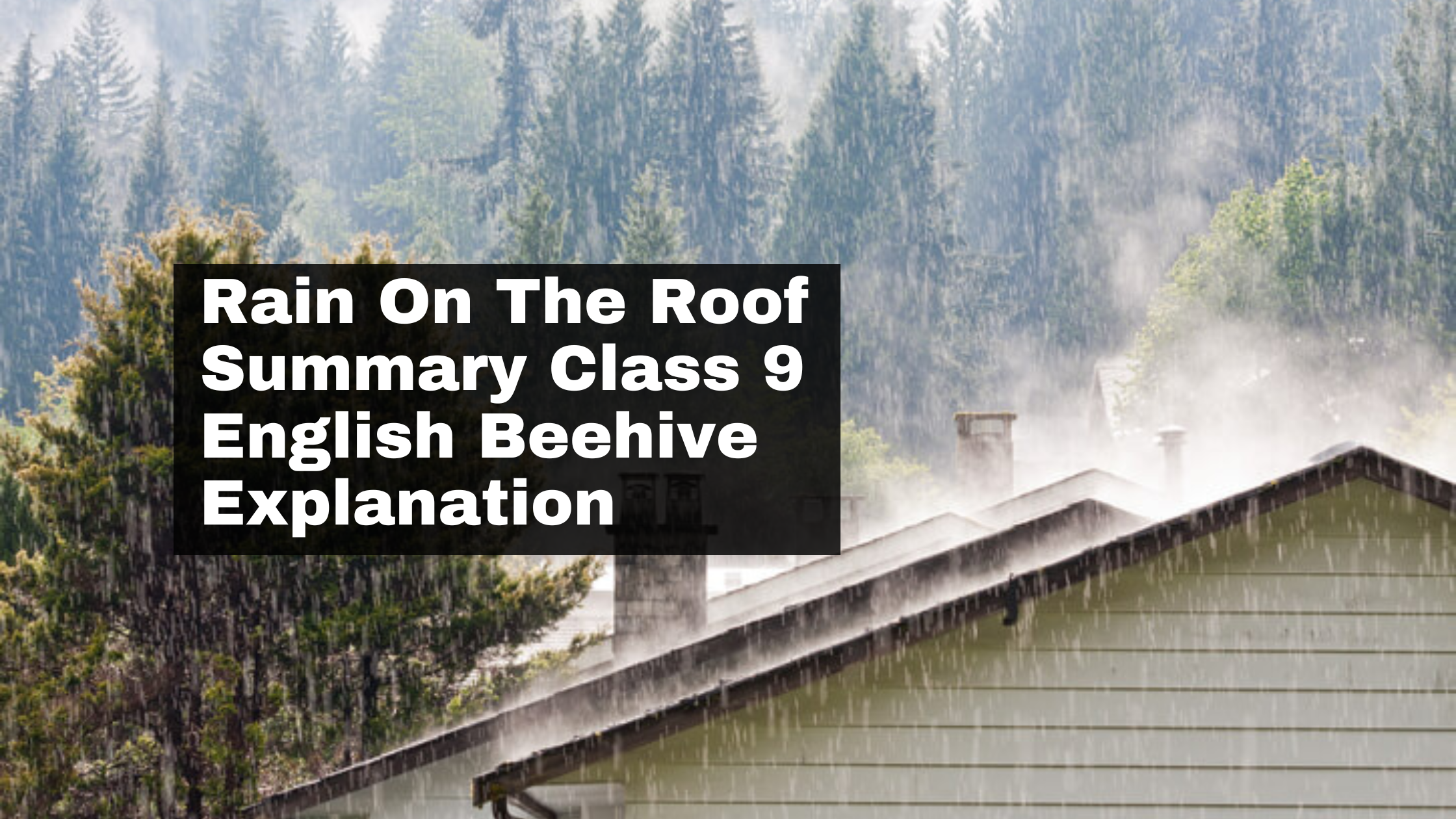The Rain On The Roof Summary tells us about the memories the poet has attached with the rain. The sound of the downpour falling on the roofs takes him to the past sweet memories.
He describes varied reactions to it and compares raindrops to tears shed at night. He loves to lie in bed and falling drops on the roof take him back to the past where he has memories of his mother.
In the article, we have discussed the Summary of the rain on the roof along with the poetic devices and ncert solutions. We have also mentioned the central theme and the author’s bio. Let’s begin the poem line by a line explanation
You can also watch our video on rain on the roof class 9th ncert English poem for better understanding.
Rain On The Roof About The Author
The poem has been written by Coates Kinney, who was born in New York and educated at Yellow Springs. Through this poem, the poet feels nostalgic as soon as raindrops fall on the roof.
He gets lost in the sweet memories of the past where he also compares the drops falling with the tears shed at dark nights. He also remembers his mother and how he used to sleep in her lap.
Rain On The Roof Central Theme
The poem has a central idea stored in as Kinney considered rain as the healer. The musical sound of the drops falling on the rooftop late at night. Through this, he was able to cherish the sweet memories of the past. The rain heals his mind of the busy life and takes him back to when he used to sleep in her mother’s lap.
Rain On The Roof Poem Explanation
Stanza1. When the humid shadows hover Overall the starry spheres And the melancholy darkness Gently weeps in rainy tears, What a bliss to press the pillow Of a cottage-chamber bed And lie listening to the patter Of the soft rain overhead!
Meanings
- Humid: something which is full of moisture.
- ‘shadows’ refers to the moisture-laden clouds which cast a shadow on the earth.
- hover: Move around something
- melancholy: sad
- bliss: Happiness
- patter: the sound of raindrops falling on the roof.
- Cottage chamber means the bedroom.
In the above stanza, the poet says that as soon as the humid shadows cover the sky. The poet meant to say that when the sky is filled with these moisture-carrying clouds, which are about to bring rain. The gloomy darkness that haunts the night moves away slowly.
The poet is also comparing the drops of rain to the tears falling from the eyes on dark gloomy nights. He further says that it seems to be a vouchsafe to lie down as the drops fall on the roof and listen to musical drops of falling raindrops.
Poetic devices
The rhyme scheme of the poem: abcbdefe
Stanza 1
- Alliteration: The repetition of a consonant sound in two or more consecutive words.‘Humid Hover’ – ‘h’ sound is repeating ‘starry spheres’ – ‘s’ should be repeated ‘press pillow’- ‘p’ sound is repeating ‘lie listening’ – ‘l’ sound is repeating.
- Onomatopoeia: The use of sound words to create a dramatic effect and auditory imagery. ‘Patter’ is the use of sound words. It is the sound made by the raindrops falling on the rooftop.
- Personification: Treating a non – living thing as a living being, darkness has been personified when he says that it is sad.
- Transferred Epithet: The use of an adjective with a noun when it refers to another noun. In ‘melancholy darkness’, the darkness is not melancholy, but it refers to the sad people.
Stanza2. Every tinkle on the shingles Has an echo in the heart; And a thousand dreamy fancies Into busy being start, And a thousand recollections Weave their air-threads into woof, As I listen to the patter Of the rain upon the roof.
Meanings
- tinkle: short, light ringing sound
- shingles: rectangular wooden tiles used on roofs
- echo: repeated sound
- woof: weft, i.es the thread woven across the loom
- patter: the sound of raindrops falling on the roof
- ‘busy being’ refers to human beings and here, the poet is referring to himself
As soon as he hears the drops falling on the roof, he expresses that the sound falling on the rooftop echoes in his heart. In his dreams, he also makes some fancy imaginations related to this.
He also tries to collect and cherish the sweet memories of the past. So with every pitter-patter raindrops falling on his roof, his heart also stores that sound and takes him back to the past.
Poetic devices
1.Alliteration: The repetition of a consonant sound in two or more consecutive words.
‘busy being’ – ‘b’ sound is repeating
‘their thread’ – ‘th’ sound is repeating
‘rain roof’ – ‘r’ sound is repeating
2. Onomatopoeia: The use of sound words to create a dramatic effect and auditory imagery.
‘tinkle’, ‘patter’ – sounds made by the raindrops.
3. Personification: Treating a non – living thing as a living being.
recollection is personified when he says that they weave dreams.
4. Transferred Epithet: The use of an adjective with a noun when it refers to another noun.
‘dreamy fancies’ does not mean that the fancies are dreamy but refers to the people who have dreams.
Stanza 3. Now in memory comes my mother, As she used in years agone, To regard the darling dreamers Ere she left them till the dawn: O! I feel her fond look on me As I list to this refrain Which is played upon the shingles By the patter of the rain.
Meanings
- ere: old poetic word for ‘before’
- dawn: daybreak
- list: old poetic word for’ listen’
- refrain: a repeated part of a song or a poem; here, the sound of the rain
In the above stanza, the poet also remembers his mother and feels her presence as he used to lie in her lap. It also brings those memories in the past and feels nostalgic as the raindrops fall on his rooftop. She used to love him and let him sleep so that he could dream.
The poet can still feel her presence as the drops of the sound fall on the roof. The sound relates him to his past and whenever he listens he gets nostalgic and gets lost in his fancy world.
Poetic devices
1.Alliteration: The repetition of a consonant sound in two or more consecutive words.
‘memory my mother’ – ‘m’ sound is repeating
‘Darling dreamers’ – ‘d’ sound is repeating
2. Onomatopoeia: The use of sound words to create a dramatic effect and auditory imagery.
‘patter’ – the sound of raindrops falling on the shingles of the roof.
Rain on the Roof Class 9 NCERT Solutions
Q1.What do the following phrases mean to you? Discuss in class.
(i) humid shadows
(ii) starry spheres
(iii) what a bliss
(iv) a thousand dreamy fancies Into busy being the start
(v) a thousand recollections weave their air-threads into woof
(i) ‘humid shadows’ refer to the dark clouds which are filled with water.
(ii) ‘starry spheres’ refers to the sky at night, full of stars.
(iii) ‘bliss’ means a blessing.
(iv) ‘a thousand dreamy fancies into busy being start’ means that people start having varied sweet dreams.
(v) ‘a thousand recollections weave their air-threads into woof’ means that when people are asleep, the memories of the past come back into their mind in the form of dreams.
Q2. What does the poet like to do when it rains?
When it rains, the poet likes to lie down in his bed and hear the drops falling on the roof of his room.
Q3. What is the single major memory that comes to the poet? Who are the “darling dreamers” he refers to?
The poet reminisces of his mother who is no more. When he was a small kid, he would put him and his siblings to bed and allow them to sleep and dream. Darling Dreamers refers to the port and his siblings as they had sweet dreams while sleeping and they were darling as their mother used to love them.
Q4. Is the poet now a child? Is his mother still alive?
No, now the poet is not a child. He is a big grown man and his mother is not alive anymore.
Conclusion
To sum up, we have provided the students with a detailed explanation of Rain On The Roof along with their meanings and poetic devices. The summary of rain on the roof has been written by Coates Kinney and he through this poem has attached the drops of rainfall with his sweet old memories of the past.

